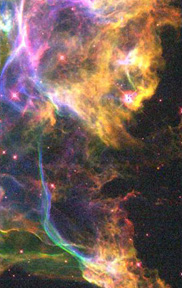
AST 393F
SURVEY OF THE INTERSTELLAR MEDIUM
Instructor: Harriet Dinerstein
Semester: Spring 1997
Meeting Times: TTh 9:30-10:45 a.m.
Unique No: 42320

|
AST 393FSURVEY OF THE INTERSTELLAR MEDIUMInstructor: Harriet Dinerstein Semester: Spring 1997 Meeting Times: TTh 9:30-10:45 a.m.
Unique No: 42320 |
| GOALS: | The purpose of this required ("core") course for first- and second-year astronomy graduate students is to provide a broad overview of the interstellar medium. I intend for it to serve as a general introduction for those who are considering doing research in this field, but it should also give others enough background to be an informed audience for talks and papers on this field. |
| TEXTS: | Essentially, my course notes are the textbook. Spitzer's Physical Processes in the ISM (1978) is still the most complete general reference book available, but it is organized into chapters by physical process, whereas I prefer to structure the course around major components of the ISM: which reactions and processes are important in each, and how we study them. Several copies of Spitzer have been ordered by the UT Co-Op. Also, it and several other useful books will be on reserve in both the Péridier and PMA libraries (and can be checked out from the latter for three days). |
| COURSE WORK: | There will be of order 5-6 problem sets, mostly concentrated in the first half of the semester, worth about 25% of the grade. A midterm will be given in class, probably the week after spring break, for 20%, and a comprehensive final exam during finals week, worth 25%. The rest of the grade will be based on oral presentations to be scheduled in mid-April and the written course notes for these presentations, plus a short (1-2 page) standard-format research proposal, which can be on the same topic as the oral presentation if the student wishes. |
OUTLINE (subject to revision):